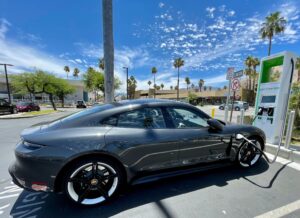Europe, unlike other key EV markets, has experienced unprecedented growth in EVs. EV sales increased by double-digit percentages in almost every European country in 2019. BEV (battery electric vehicles) and PHEV (plug-in hybrid electric vehicles) sales saw a 143% increase in 2020, making Europe the largest EV market globally, surpassing China and surged again in 2021 with sales of 1,143,000. Some reasons for this rise could be increased demand for new models, availability of existing models with large battery sizes, charging infrastructures and supporting government initiatives. But smaller markets like Estonia, Iceland and Slovakia saw sales decline in absolute terms during the pandemic. According to an article published by The Forbes, although sales of BEVs are exploding in Western Europe, but growth will slow down over the next couple of years, to 12.0% in 2022, 13.0% in 2023 and 15.0% in 2024, before jumping 5 points to 20.0% in 2025 and an estimated total of 2,860,000.
EV-EuropeStatistics (as of FY20):
Individual European markets shares of new EV sales: Norway (75%), Sweden (32%), the Netherlands (25%), Finland (18%), Denmark (16%), Switzerland (14%), Portugal (14%), Germany (13%), France (11%), Belgium (11%), and the United Kingdom (11%).
Model availability at national level: Germany (132), the Netherlands (112), the United Kingdom (110), France (110), and Norway (109).
Amount of installed public chargers: The Netherlands (65,600), France (46,000) and Germany (44,700).
Ratio of EVs per charger: The Netherlands (4.6), Italy (7.5), Finland (8.9), Sweden (20), Norway (25).
Top players and bestselling models in Europe:
#1 Volkswagen (Germany): It’s the world’s third most popular EV manufacturer with a goal to produce 50 electric car models by 2025, by investing over €30bn into EV related technologies. It also aims for the majority of its vehicles to be zero-emission worldwide by 2040. The automobile group itself aims to be carbon neutral by 2050. VW offers two EV models: the e-up! and e-Golf. The company owns 12 renowned brands including Porsche, Audi, Bentley, Bugatti and Lamborghini. The VW group holds 10% market share in EV and sold 290,000 EVs in 2021.
#2 Renault Group (France): Renault Group was the first to believe in all-electric mobility, and still leads the way. Standing at the second position, after Tesla, Renault Group represents more than 15% of all EVs sold in Europe in 2020. On a global scale, around 460,000 EVs have already been sold by the group. Models of electric vehicles by the Renault-Nissan-Mitsubishi alliance, for example, the iconic Nissan Leaf and Renault Zoe, are created to have a decent range with zero-emission. The cars are designed for mass market and are responsive and smooth.
Bestselling EV models in Europe: Renault ZOE (15%), Tesla Model S (14%), Mitsubishi Outlander PHEV (10%), Nissan LEAF (8%), BMW i3 (7%), Hyundai IONIQ Electric (4%), Volvo V60 Plug-in Hybrid (4%), Opel Ampera (3%), Tesla Model X (3%), Volkswagen e-Golf 2017 (3%) and others (29%).
Government stimulus:
- Governments in countries with major OEMs are prioritizing the improvement of EV automation with the ambition to evolve the technology and keep the value chain in the country.
- The European Union’s new emission standard of 95 grams of carbon dioxide per kilometre for passenger cars and light commercial vehicles (LCVs) stipulates that 95% of the fleet must meet this standard in 2020 and 100% in 2021.
- Government is devoting funds in EV infrastructure and mobility programs to stimulate supply: For some years already, government investment in Europe has been towards EV-related R&D. Many governments are financing EV-supporting infrastructure (e.g., charging stations, special parking spots). Governments are also proving to be constant pillars for mobility programs, which address environmental issues, congestion problems, or both.
- Subsidies, tax breaks, and special driving entitlements encourages demand: Many European governments and cities (e.g., Norway, Denmark, the Netherlands, France, UK, as well as Oslo, Amsterdam, Paris, and London) are impelling buyers to opt for electric mobility, each with their own schemes. Purchase, lease, and road taxes are among the burdens being relaxed by governments to make EVs a more appealing choice to customers.
- Another push for EV growth from the governments of most major European countries comes from the desire for higher energy independence and a shift towards a less oil-intensive transport sector.
- Other benefits offered by governments (mostly cities) includes the use of special driving lanes, preferential or free parking, and waiving of toll fees.
The trajectory and ultimate scale of adoption of EVs in Europe remains uncertain. However, at ‘Untapped Markets’ we believe that the developments to date and some indicators looking forward suggest significant potential in the market.




